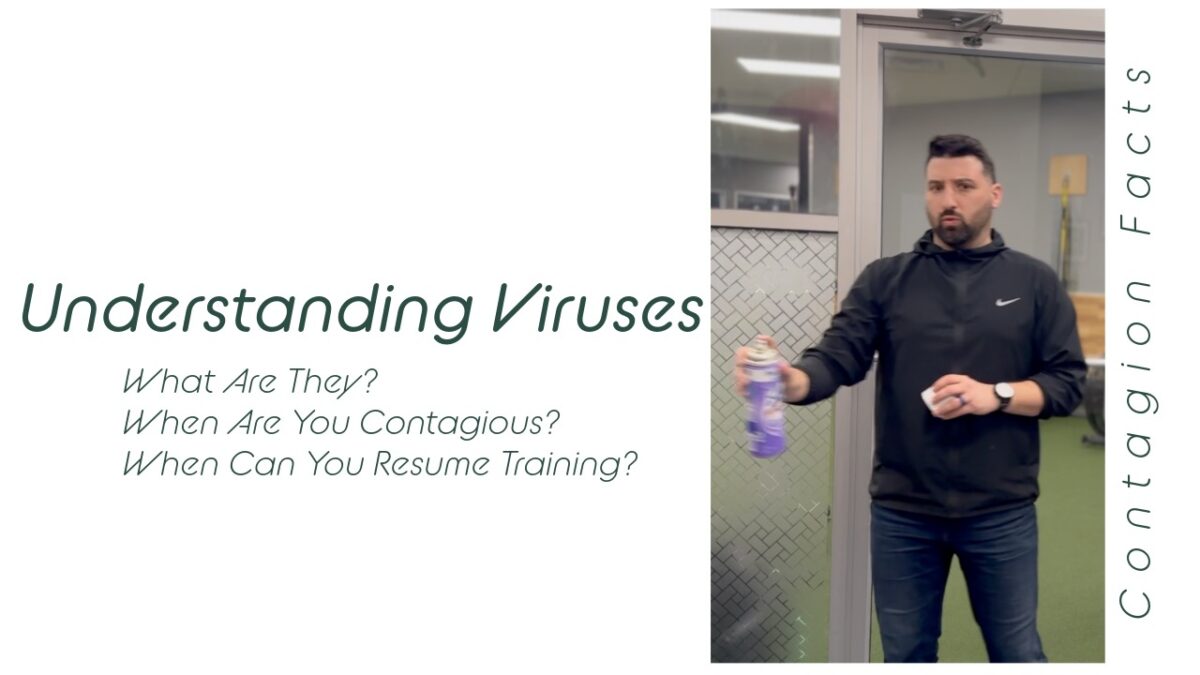
What Happens When A Physical Therapist Gets Injured?
February 21, 2024
How Does Stress Affect Your Healing?
April 13, 2024What is a Virus? When am I Contagious? When Can I Train Again?
Local college athlete, Izzy, wanted to know what happens when someone gets sick and more importantly when someone is contagious when they are sick. I think that’s an excellent question and a topic worth discussing a bit. Seeing as how we are coming to the tail end of our Winter and many of us got sick the past few months let’s dig into this a bit.
Viruses are responsible for many of the common illnesses that make their rounds during the winter months. A virus is a “non-living” microbe that infects a host to live, replicate, and ultimately causes an infection. It is “non-living” because it cannot replicate on its own and it requires a separate living host..this means us! The type of infection depends on the specific type of virus and I want to take some time to dive into some of the more common viruses we see.
When the colder months come it creates a better environment for viruses to live. The cooler and dryer air allows viruses to live longer and ultimately increases the risk of contraction and spread. Combine that with more time spent indoors in close quarters, especially around the holidays, and it’s no wonder the winter months see a higher rate of sickness.
The “common cold” is a sort of catch-all term and it isn’t one specific virus. Five of the most common viruses share symptoms and can often be confused with one another unless a proper medical checkup is performed. Coronavirus, influenza, rhinovirus, adenovirus, and RSV are the more common culprits that wreak havoc during the holiday season. While they are definitively separate, the more mild and common infections will frequently have similar presentations.
To better understand the symptoms we should break them up into categories and talk about some common symptoms or even phrases that you may have heard before
Flu-Like: Fever, chills, body aches
Upper Respiratory: Dry cough, sore throat, headache, runny nose, stuffy nose
Lower Respiratory: Mucous-y productive cough, shortness of breath, chest tightness, wheezing, etc.
Digestive: nausea, vomiting, diarrhea
The upper respiratory symptoms are often less severe however they can progress into something more aggressive like lower respiratory infections which tend to linger a bit and can be more concerning, especially for those “at risk” populations (elderly, very young, or immuno-compromised). There’s not much you can do to speed up the process if you’re sick however you can do quite a bit to screw it up and make it last longer.
A virus must run its course so you should put your body in the best possible situation to heal. Prioritizing good sleep, hydration, and nutrition will do wonders for your timeframe. In addition, stress reduction helps significantly as well as making sure you are not over-exerting yourself day to day. These are things that will allow your body to protect itself as the virus gets the boot from your immune system.
When choosing to return to activity be sure to keep it low intensity early on and the longer you are “out” then the more time you should take to ramp your activities back up. We also recommend using “the neck rule” for gauging symptoms. Meaning if you participate in low or moderate-effort exercises then be sure your symptoms (if present) stay above your neck. If you start to experience some lower respiratory symptoms then you should shut it down and rest up.
When gauging “contagiousness” there seems to be a pretty simple formula. For most viruses you’re going to be contagious 2-4 days before symptoms and then up to 14 days after symptoms begin. This is a good general rule of thumb unless you’re dealing with digestive viruses (stomach bug, norovirus, etc) which will generally be 1-2 days before symptoms begin and 3-4 days after symptoms start. They don’t last long but they spread very easily. Unfortunately, the best recommendations revolve around this general window for symptoms as there can be too much variability in everyone’s situation.
While there seems to be an endless amount of information to talk about regarding viruses, I hope this breaks it down a little bit for you. Viruses can be straightforward but the subtle differences in symptom presentations make these few noteworthy to discuss with you. So just remember you may be contagious for quite a while and the best thing you can do is rest and drink plenty of fluids.
Let us know if you have any questions. And Happy Healing!





